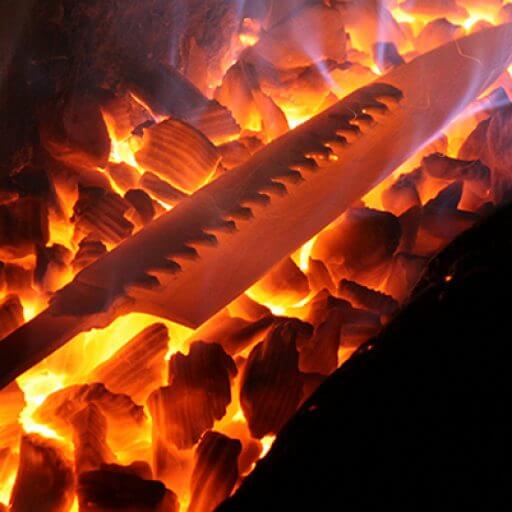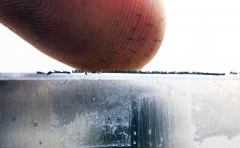the blade rather than the edge

After a long time, I sharpened a kitchen utility knife meant for interrupting the work in the home. The request was simple: they wanted it to cut tomatoes smoothly (^^)b. I had some free time in the morning, so I decided to give it a good sharpening.
When it comes to making a knife cut easily, it’s as simple as removing any small chips in the blade. Such a task can be completed in no time if you use a machine, taking just about 20 seconds to do both sides. Sharpening a knife, when done right, is a fast process, as you can put an edge on it quite quickly.
The challenge in knife sharpening might not be the basic concept of grinding an edge but rather adjusting the blade itself. In simple terms, shaping everything other than the edge (the blade part) can be the real challenge. For home utility knives, they usually have quite sturdy blades due to their construction, but when they lose their sharpness, it can be a bit of a hassle to restore their cutting power.
While there are simple sharpening tools available, they merely touch up the edge, serving as temporary solutions. To return a knife to its factory condition or even make it sharper than new, it’s crucial to eliminate the secondary bevel created by the initial edge setup. To do this, you’ll need to reshape the blade itself.
It might seem like a futile effort since you’re sharpening the part of the blade that doesn’t come into direct contact with the material you’re cutting. But once you perform this reshaping, you’ll be amazed at how much better the blade’s performance becomes. You’ll experience that smooth and effortless cutting feeling.
When it comes to effortlessly slicing tomatoes, it’s not just about the sharpness of the blade’s edge; it’s also about how well it glides through. It’s a battle against friction.
Merely thinning the blade doesn’t always work; it can lead to sticking. That’s where a bit of creativity comes in. I added some hamaguri (clamshell-shaped) features to the blade. This allows for a kind of shaping that addresses the problem.
Once the blade is shaped in this way, you can further refine it by using sharpening stones, extending and thinning the edge by 2mm to 3mm. This achieves the sharpness you’d typically associate with traditional Japanese knives. However, considering that this knife is intended for home use and the user might be someone not as experienced, I added an itohiki (small secondary bevel) to make it more user-friendly.
At this point, you might have mixed feelings about ‘killing’ the edge that you worked so hard to extend. But opting for a sturdier edge is better than one that chips easily. While this might not be a strict adherence to traditional sharpening techniques, because of the precise blade shaping, it still delivers fantastic cutting performance without you even noticing the secondary bevel. This aspect could be a significant factor influencing the quality and level of your sharpening.
Tonight, I’ll be delivering the sharpened knife. I look forward to hearing the feedback in the days to come. I poured my heart into the sharpening process. Achieving sharpness is one thing, but maintaining it over time is another challenge.
hibishugyo
2007-04-25





